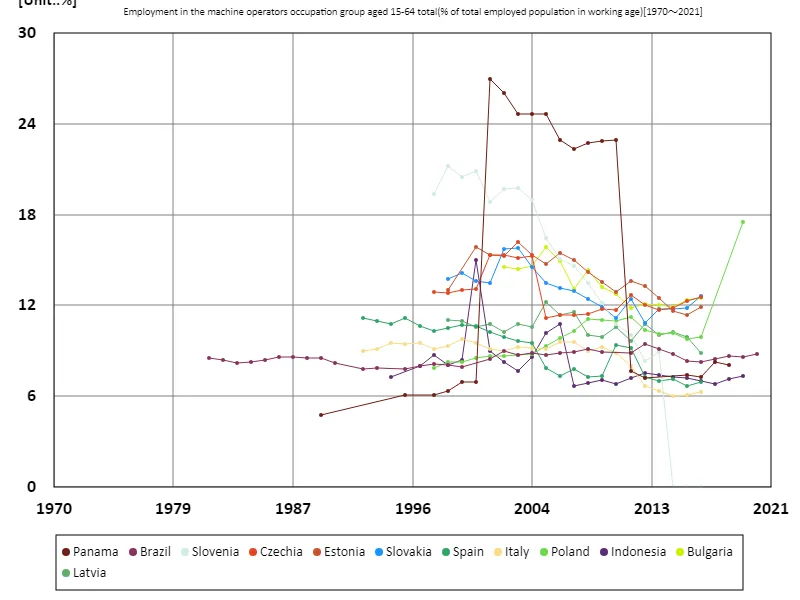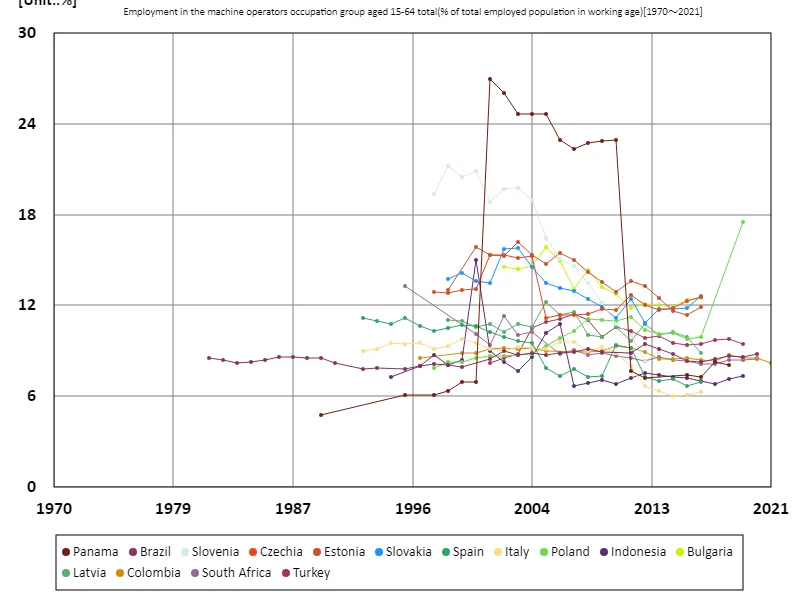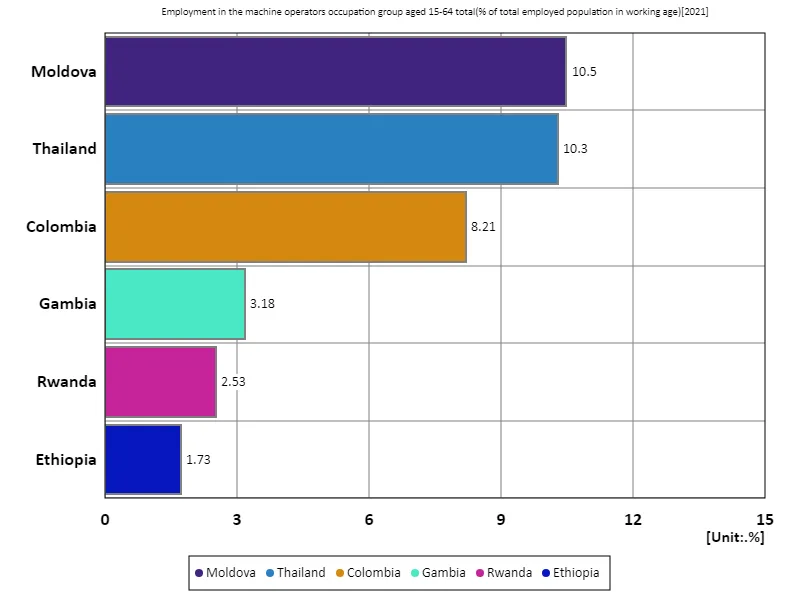- Abstract
- Employment rate of machine operators for all 15-64 year olds (percentage of working-age employed population)
- Employment rate of machine operators (percentage of working-age population) for all 15-64 year olds (worldwide)
- Employment rate of machine operators for all 15-64 year olds (percentage of working age employed population) (Worldwide, latest year)
- Reference
Abstract
Data on employment rates is an important indicator of the economic structure and industrial development of each country or region. According to 2020 data, Brazil had the highest employment rate of machine operators at 8.82%, reflecting the relatively strong presence of machinery-intensive industries in the country, such as manufacturing and mining. This is thought to be related to Brazil’s industrial structure’s dependence on heavy industry and resource extraction. On the other hand, in developed countries, employment rates for machine operators tend to be relatively low due to the advancement of industrial sophistication and automation. Additionally, in developing countries, the demand for machine operators often increases as the manufacturing industry grows. These trends are also influenced by each region’s industrial policies and stage of economic development, so a deeper analysis of the data can help us understand the characteristics and changes in each country’s economy.
Employment rate of machine operators for all 15-64 year olds (percentage of working-age employed population)
Based on data from 1981 to 2020, a notable trend in employment rates for machine operators can be seen. Notably, Panama’s 27% figure in 2001 was the highest overall, reflecting the country’s growing reliance on machinery in its fast-growing manufacturing and construction industries. Since this peak, Panama’s employment rate has fallen slightly, currently standing at 29.9%, and demand for machine operators remains high. Looking back at data from the past few decades, employment rates for machine operators have generally declined in developed countries due to technological change and increased automation. Especially in the 1980s and 1990s, developed countries increased automation in manufacturing, reducing the demand for machine operators. On the other hand, in developing countries, as the manufacturing industry grows, the demand for machine operators is high and employment rates tend to be high. Countries like Panama, where employment rates of machine operators are high during economic growth, exhibit specific employment patterns due to a combination of industrial development and structural changes in the labor market. Overall, there is a clear polarization between automation in developed countries and growth in developing countries, with the employment rate of machine operators being an important indicator reflecting a country’s stage of economic development.


The maximum is 27%[2001] of Panama, and the current value is about 29.9%
Employment rate of machine operators (percentage of working-age population) for all 15-64 year olds (worldwide)
When analyzing the evolution of employment rates for machine operators using data from 1981 to 2021, several key trends emerge. Panama’s peak of 27% in 2001 reflects the high reliance on machines in its fast-growing manufacturing and construction industries at the time. Interestingly, Panama’s current employment rate is 29.9%, up from its peak. This reflects the continued high demand for machine operators as Panama’s economy grows. In general, in developed countries, as automation in manufacturing progressed from the 1980s to the 1990s, the employment rate of machine operators tended to decline. In developed countries, high levels of technological innovation and efficiency have led to a reduction in the role of machine operators. In contrast, developing countries and emerging markets are seeing an expansion of manufacturing and the introduction of more machinery, creating high demand for machine operators and ensuring that employment rates remain relatively high. Overall, the employment rate of machine operators is an indicator that reflects the stage of economic development and changes in industrial structure, with significant differences between developed and developing countries. The case of Panama in particular shows that economic growth and industrial development directly affect employment rates, making it an important example for understanding the dynamics of the job market for machine operators.


The maximum is 27%[2001] of Panama, and the current value is about 29.9%
Employment rate of machine operators for all 15-64 year olds (percentage of working age employed population) (Worldwide, latest year)
Based on 2021 data, the employment rate of machine operators shows an overall average of 6.07%, with the maximum value being 10.5% in Moldova. The data reflects differences in each country’s economic structure and industry dependency. Moldova’s high employment rate suggests that the country’s manufacturing and heavy industry are relatively well developed, creating a high demand for machine operators. Over the past few decades, developed countries have seen an increase in automation in manufacturing, while employment rates for machine operators have declined. Meanwhile, in developing countries and emerging markets, the demand for machine operators is high due to the growth of the manufacturing and construction industries, and employment rates remain relatively high. Countries that rely on specific industries, like Moldova, often have above-average employment rates for machine operators. The overall combined employment rate of 36.4% indicates that machine operators remain an important occupation in many countries. This reflects the fact that the manufacturing and construction industries remain strong in many regions and countries, and it is important to conduct analysis that takes into account future changes due to industrial development and technological innovation.


The maximum is 10.5% of Moldova, the average is 6.07%, and the total is 36.4%



Comments